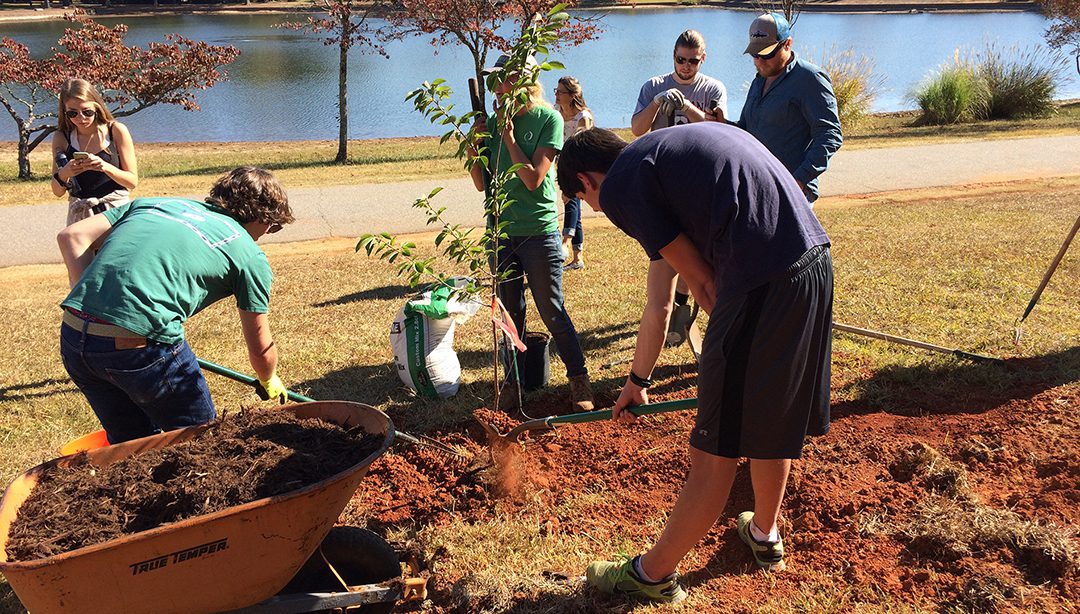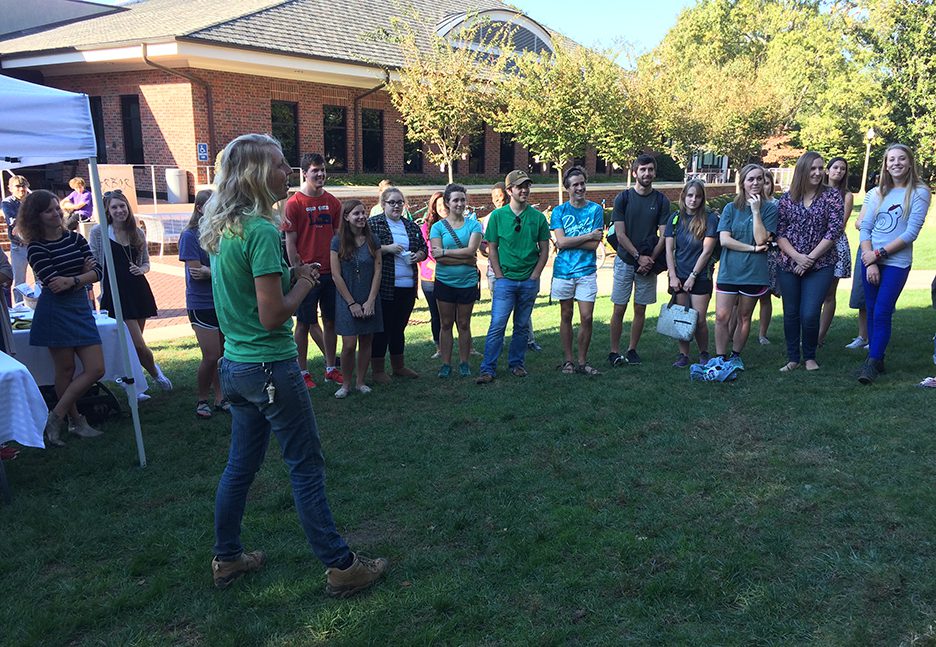Cherry blossoms for Arbor Day

Arbor Day 2016 was a special one for Furman. While the national celebration of Arbor Day is slated in April, Furman University observes Arbor Day on campus in October. Furman’s event—held in compliance with its designation as a Tree Campus USA in 2008 by the Arbor Day Foundation—often includes the planting of trees, and fall is the best time to do that in South Carolina.
During the celebration on Oct. 28, 2016, students from Furman’s Greenbelt Community and faculty members teamed up with Trees Greenville and Furman grounds keepers to plant 11 Japanese mountain cherry trees. The young trees, which range from five- to eight-feet tall, were a gift to the university from the Japanese government. Since there was no remaining space in Furman’s tranquil Asia Garden to put the saplings, grounds keepers chose to site the cherries on the back side of campus, near the lake.

Students Juhi Saxena ’19 and Noa Camp ’19 complete the last step in the planting process, applying mulch to hold soil moisture and provide nutrients for the growing trees.
The story of how Furman came to be the recipient of these unique trees began several years ago when the Consulate General of Japan contacted Furman to ask if the university would be interested in receiving some cherry tree seedlings to mark the 100th anniversary in 2012 of the gift of 3,020 cherry blossom trees from the people of Japan to the people of the United States. Those trees, the majority of which were planted around the Tidal Basin in Washington, D.C. in 1912, are the centerpiece of the national capital’s annual Cherry Blossom Festival in April.
Known as the Nationwide Cherry Blossom Tree Planting Initiative, the contemporary program set out a goal of planting a minimum of 3,000 new trees under the auspices of the nonprofit conservation group American Forests, in consultation with the Embassy of Japan and the Consulates General of Japan. The trees were only offered to select campuses and organizations.
Furman’s Senior Grounds Keeper Sheree Wright responded to the Japanese Consulate that Furman would be honored to have some cherry tree seedlings, and requested varieties that would thrive in the soil and climate of the South Carolina Piedmont. The trees they sent, Japanese mountain cherries (Prunus yamazakura), were three-inch-long bare roots called “liners” when Furman received them in 2013.
Wright planted the roots in one-gallon containers and cared for them in the campus plant nursery. When they got big enough, the tiny trees were replanted in three-gallon containers and left there until they reached a height of four to five feet, large enough to put in the ground this past October.

Kylie Stackis ’14, program director at Trees Greenville, discusses the important roles urban trees play on campus and in our communities.
The cherry trees will eventually be labeled (they are too small to label now) as part of Furman’s George G. Willis Arboretum, a Level 1 arboretum accredited by the Morton Registry of Arboreta. Furman began a program of labeling tree species on campus in 1998 under the management of Rose J. Forgione Professor of Biology Joe Pollard. “At last count, we have 300 individual trees labeled,” Pollard states. “Most of them are clustered around high-traffic areas of the campus.” Labels note the family, species and native origin of the trees.
“Every time you add something new, it enhances the arboretum,” says Sheree Wright. “The cherry trees will beautify the back side of campus, where you will be able to see them from the dining hall.” As they mature, the Japanese mountain cherry trees will eventually form a grove, adding their delicate pale-pink blossoms to the beauty of Furman’s campus in the spring.